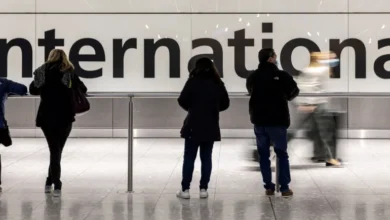US election results: How did Donald Trump break the ‘blue wall’ – again?

Former President Donald Trump’s victory in the US presidential election has been helped in no small part by his winning of multiple so-called “blue wall” states that are traditional Democrat strongholds.
As the Electoral College voting map gradually turned red after polls closed and votes were being counted, observers initially suspected the “red mirage” effect, which can be produced as more Republican voters (denoted by red) tend to go to the polls in person and more Democrats (denoted by blue) mail in their votes.
Once Trump crossed the line of 270 Electoral votes, however, Democratic hopes of catching up to his lead in the early counting stage were dashed.
What is the red mirage?
Historically, more mail-in ballots are sent by Democrats while more Republicans vote in person.During the 2020 election, the electoral map looked similarly red in the early hours of counting, leading Trump to claim an early victory, before results in critical battleground states had been announced.
When results concluded after mail-in ballots were counted, Democrat Joe Biden emerged as a winner, after counting of postal votes showed he had won back Pennsylvania, Georgia, Michigan and Wisconsin, some of which are blue wall states and all of which had been won by the Republicans in the 2016 election.
Similar blue shifts after an initial red mirage were expected by some analysts this year. However, by 6am ET (11:00 GMT) on Wednesday, the Associated Press (AP) had projected 277 Electoral College votes for Trump, seven more than the 270 required to secure a presidency.
Later on Wednesday, that number ballooned further, after Michigan, one of the so-called blue wall states, was also called for Trump.
What is a blue wall state?
A blue wall state is one the Democrats have reliably won through most of US modern history.
Precisely, these are states that voted for Democrats in every election between 1992 and 2012. They include California, New York, Illinois, Pennsylvania, Michigan, New Jersey, Washington, Massachusetts, Maryland, Minnesota, Wisconsin, Oregon, Connecticut, Hawaii, Maine, Rhode Island, Delaware and Vermont as well as the District of Columbia.
In 2016, Trump breached the blue wall, flipping several of those states to red in the election against Democrat Hillary Clinton. These included Pennsylvania, Wisconsin and Michigan – all three of which were again major battleground states during the latest election.
In 2020, President Joe Biden won back all three of these states, seemingly resurrecting the blue wall.
What happened in the three swing states behind the blue wall?
Away from the swing states, AP called reliable Harris wins in all the other blue wall states. However, AP called Trump wins in the three critical battleground states behind the blue wall – enough to cost Harris the presidency.
Here is how Trump fared in the three swing states considered to be behind the blue wall this year:
- Pennsylvania: AP has called a Trump win in Pennsylvania, which has 19 Electoral votes, by two percentage points. Ninety-eight percent of the votes have been counted.
- Wisconsin: AP also called a Trump win in Wisconsin by 0.9 percentage points, with about 99 percent of the votes counted. Wisconsin has 10 Electoral votes.
- Michigan: By Wednesday evening, AP also called Michigan for Trump. He is leading the state by 1.4 percentage points, with nearly 99 percent of the votes counted. Michigan carries 15 Electoral College votes.
How did Trump breach the blue wall?
People are over the pandemic
Schultz said he believed Biden was able to reclaim blue wall swing states from Trump in 2020 in part because of the way Trump handled the COVID-19 pandemic during his presidency.
More than 1.1 million people died during the pandemic in the US – from the time of the emergency declaration in January 2020 until when it was lifted in May 2023.
During the early months of the outbreak, Trump undermined scientists and spread false claims about the coronavirus on his social media platforms, such as the idea that children are “almost immune” to it.
Anti-vaccine misinformation spread and people in many Republican-led states started rallying for relaxed quarantine restrictions and questioned mandatory vaccine requirements.
In February 2021, a Lancet commission tasked with assessing Trump’s health policy found that 40 percent of deaths from the virus in the US could have been averted if the US death toll corresponded with that in other high-income Group of Seven (G7) countries.
Cost of living and the economy
Now, however, “economic issues along with feelings of being ignored drove the Trump victory”, Schultz said. Democrats “failed to execute well in the three blue wall states”, focusing too much on abortion over other issues such as economic policies that would appeal to working-class voters, he said.
A preliminary national exit poll conducted by data provider Edison Research showed that 51 percent of voters trusted Trump with handling the economy compared with the 47 percent who trusted Harris.
According to the exit poll, 31 percent of voters said the economy mattered most in shaping their decision to vote, whereas only 14 percent cited abortion.
“The Harris campaign did not necessarily do a good job of explaining how her policies would help the middle class, or at least that message wasn’t really resonating with a lot of voters,” Melissa Deckman, a political scientist and the CEO of Public Religion Research Institute, told Reuters news agency.
Choice of running mate
Deckman added that Harris’s VP choice of Minnesota Governor Tim Walz over Pennsylvania Governor Josh Shapiro was one of “several mistakes” made by the Democrats in the run-up to this election. This is because Walz did not help Harris win any swing states. Minnesota has voted blue in every single election since 1976.










